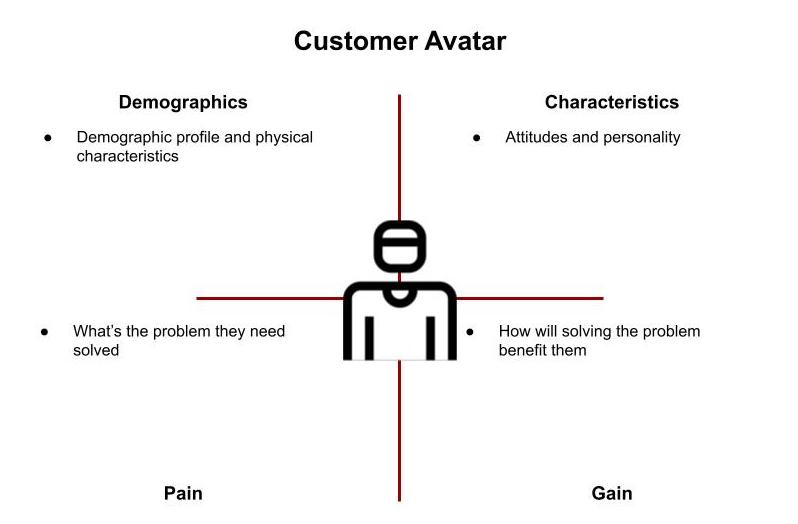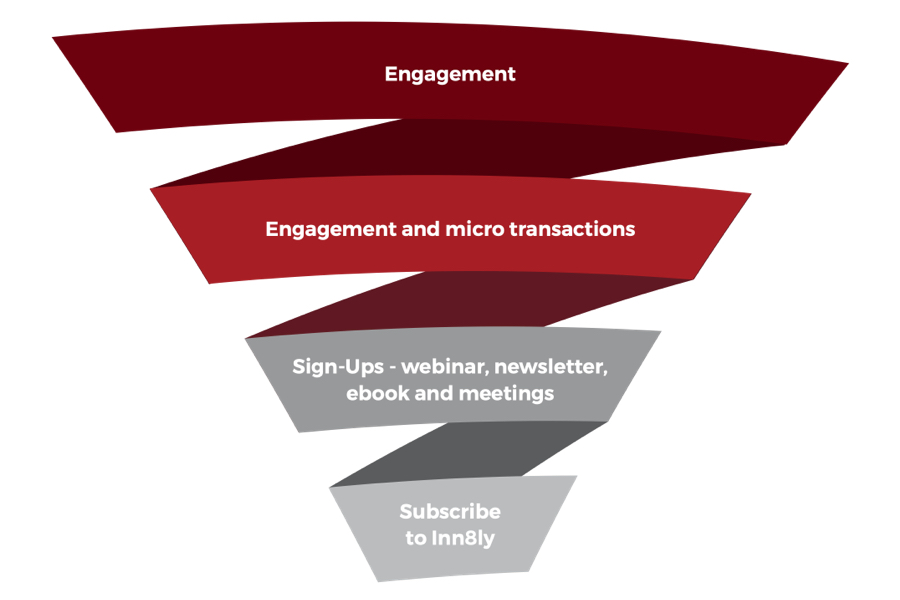A successful digital marketing strategy involves more than just putting a message out there and hoping that users bite. If you leave everything to chance, then you’re not executing a strategy, but trying random tactics and hoping that one will work.
The approach that we suggest for digital marketing is more focused. Our strategy is based on four pillars: your audience, their needs, campaign design, and the step-by-step process of putting all those elements together. It’s also based on the hub and spoke strategy. A well-designed and well-built website is the hub through which your online marketing flows.
In this article, we’re going to describe each pillar. Specifically, the list, the offer, the creative, and the process. If that doesn’t make sense right now, don’t worry – it will in a few minutes!
The List

If you want to market a product or service, it all starts by putting together a customer profile for your ideal audience. We call this process the ‘list’ because, in the vast majority of cases, you have more than one type of customer that you want to target – in other words, you’re building an ideal buyer list.
To succeed when it comes to targeted marketing, you need to know the answers to questions such as:

- What are the demographics of your users or customer base (age, gender, education level, etc.)?
- What are their characteristics? What are their attitudes? What hobbies or interests do they have?
- What problems do your target customers need help solving? What’s their pain?
- How will you solve their problem? What will they gain from your products or services?
Let’s say, for example, that you run an e-commerce store that sells flowers. Demographics data shows us that women are more likely to purchase flowers than men, although men spend more on floral gifts (less frequent, but more expensive purchases).
Data also shows us that Generation X customers (those born between 1965 and 1980) are the demographic most likely to buy flowers online. It also tells us that typically, people buy flowers for their own use.
When you put all that information together, you start to get a rough idea of who your target list includes. In this example, your ideal customer would be females between the ages of 40 and 55 with an interest in home decoration, floral arrangements, or similar hobbies.
That leaves you with only one key piece of information missing. You need to figure out why your target customer wants to buy flowers. Perhaps it’s to fulfill aesthetic needs, a desire to nurture something or to feel closer to nature. For most industries, there are a lot of potential ‘problems’ that your audience may want help solving.
Since you have hands-on experience in your industry, you might already have a very accurate idea of who your ideal customers are. However, with digital marketing, we never recommend that you rely on your gut alone. In today’s data-driven world, you have access to a wealth of information about who your customers are – all you need to know is how to access it.
How To Find Your Audience List

If you want to have a full understanding of your online business’ audience, then you need to resort to analytics. With these tools, you can gain access to demographic data about your website’s visitors.
Take Google Analytics, for example. This tool can provide you with information such as visitors’ ages, genders, locations, languages, and more:
With most analytics tools, you’ll only get access to demographics for a subset of your website’s visitors. However, if you have a large enough pool of data, that information can present you with a fairly accurate breakdown of your audience.
If you haven’t set up an analytics tool for your website yet, the best time to do so is now. It takes a while for platforms such as Google Analytics to collect enough data to produce usable results.
In the meantime, your best bet is to do some research about demographics for your industry in general and see if they match up with your experience. This research process might sound a bit too intensive, but it’s perhaps the most important component to a successful digital marketing strategy.
Where To Find Your Audience

Once you’ve found your ideal customer(s), you need to figure out how to reach them. There are dozens of channels you can use when it comes to digital marketing. However, not every channel resonates with every audience. To give you an idea of what works and what doesn’t, let’s return to our online flower shop example.
Let’s say that you want to run digital ads to drive traffic to your flower shop and want to use social media to do it. Right off the bat, we can tell you that purchasing sponsored tweets or LinkedIn ads isn’t likely to pay off.
Demographics research tells us that Twitter is more popular with men. While LinkedIn appeals to both genders, it’s geared towards Business-To-Business (B2B) marketing and professionals looking to network with one another and learn industry news.
In other words, most people on these platforms aren’t looking to buy flowers online. More effective and strategic options would include Instagram, Pinterest, and Facebook. Let’s break down the thought process behind using each of these platforms for our hypothetical business:
- Instagram: This platform’s audience skews towards females, with a significant percentage of its users falling in the 30–49 age range.
- Pinterest: This is perhaps the best platform when it comes to promoting decor content, plus its audience is predominantly female and within our hypothetical target age range.
- Facebook: Surprisingly enough, one of Facebook’s core audiences is women between 30–49 years old.
Of these three platforms, focusing on Facebook would perhaps enable you to scale your ads the most due to its reach. However, it can also potentially be the most expensive option and it requires more precise user targeting.
However, running ads on all three platforms would probably drain your budget far too fast and you might not be able to gather enough data to determine what resonates with your audience and what doesn’t. Ideally, you should focus on promoting your brand on one social media platform, find an ‘offer’ (more on that shortly) that speaks to them, and then scale from there.
It’s also important to note that you’re not limited to social media when it comes to digital marketing. Ideally, you’ll combine paid approaches such as online ads with other more labor-intensive but budget-friendly methods, such as Search Engine Optimization (SEO), content marketing, and email marketing.
The Offer

Identifying who your best customers are and where you can find them is only the first part of the equation. On top of that, you need to have an understanding of what kind of offers will resonate with that audience.
Fortunately, you should have already made a lot of progress towards answering this question. After all, understanding your customer’s needs and desires is one of the key considerations you need to address when identifying who those users are.
In the last section, we focused heavily on demographics and interests. Now, you need to ask yourself the following questions:
- What problems do my users and customers have?
- What questions or doubts does my audience require answers to?
- How can I provide unique solutions to those problems?
A mistake that a lot of businesses make is designing offers based only around monetary value. Offering your products at 50 percent off is fantastic, but it only works if people want those items in the first place.
Here’s an example of how to develop an effective offer. In 2020, bikes became a hot commodity due to the COVID-19 pandemic. Since many people couldn’t use public transportation, they turned to bikes, scooters, skates, and other alternatives.
If you’re running an online business that sells bikes in 2020, your first thought might be to start offering small discounts to gain an edge over your competitors. After all, people are already looking for your product, so additional marketing efforts might seem unnecessary.
In this scenario, the problem your audience faces is that they need access to a transportation method that enables them to socially distance. Some people might not have thought about bikes as the solution, which provides you with another potential audience to target.
So, how can you stand out from other bike sellers during a boom? The answer is with a killer offer on the right marketing channel. Some ideas would include promoting your products as a safe transportation method and encouraging users to join the bike-riding movement using a hashtag such as #gobybike:

Although simple discounts can net sales, we always recommend that you look for ways to tap into your customer’s emotions and needs. If you can market your business as the solution to their problems, you have a potentially winning digital campaign on your hands.
If you’re not sure if you’ve found the right angle, there are two questions we recommend you ask yourself:
- Why should users care about or pay attention to your offer?
- How can you encourage those users to take action?
Answering point number one is pretty straightforward – your target audience will care if your offer solves a real-world problem they have. If you can identify that issue and offer a solution, the effectiveness of your advertising will come down to its copy and design.
The Creative

So far, we’ve focused only on research and planning. The creative pillar is all about the actual elements that your digital ads will include. In most cases, this comes down to two components:
- Copy. The words that you use will determine the effectiveness of your ads. This applies to written copy and spoken words alike.
- Design. Even the best copy might not succeed in converting users if it’s not backed up with compelling visual design. That goes even for text-only ads, where formatting might make them more or less effective.
Designing engaging ads with gripping copy is a skill that you need to hone (or outsource). Even if you understand who your core audience is and have a fantastic offer, that doesn’t necessarily translate to a successful campaign.
If you have zero experience when it comes to digital marketing, we encourage you to research successful campaigns and study their most essential components. These include their headlines, copy, images, and Calls To Action (CTAs).
It’s important to note that we’re not suggesting you duplicate others’ ads and simply substitute your own copy and visuals. Instead, strive to develop an eye for the structures that seem to resonate with consumers, identify what imagery users connect with, and which type of language seems most effective.
All of that information will point you in the right direction when it comes to creating your own campaigns. However, it’s entirely likely that you’ll miss the mark with your first efforts. Successful digital marketing, in our experience, comes down to testing.
If you’re not seeing the results that you want, then start making changes to your campaign. You can tweak the ad’s copy, try different types of images, or modify your CTA. In most cases, we recommend that you focus on one element at a time, so that when you relaunch your campaign you can identify which elements influence its effectiveness among your target audience.
‘Mastering’ the creative pillar is all about developing a sense of what type of copy and design resonates the most with your audience. Once you’re confident in your knowledge, then you can start spending more time on small details.
The Process

Finally, you can have the right message for the right people, but if you don’t deliver it at the optimal stage of their customer journey, it won’t be effective.
Let’s say, for example, that you’re promoting an ad that encourages potential customers to buy their first bike and gain access to a safe, healthy method of transportation during a pandemic. That’s a solid message, but it’s unlikely to help you increase sales if you’re target users who have already completed purchases at your store.
This is where you can introduce a process called ‘retargeting.’ Essentially, this strategy states you can’t use the same offer for new buyers as you would for returning customers. Each type of user is at a different step of their journey and the marketing funnel.
Let’s break down the three steps of the marketing funnel briefly:
- Lead generation. Marketing at this stage should be focusing on convincing potential users to join your customer base or engage with your products in some way. Even if you don’t make a sale right away, you’re reaching out to leads who can transform into buyers down the line.
- Lead nurturing. With lead nurturing, your goal is to guide users through their journey by convincing them to take small, progressive steps towards making a purchase. For example, a customer might visit your site, sign up for your email list, and then convert due to an offer that you make weeks later after multiple messages.
- Lead acquisition and cultivation. Your user journey isn’t over after they make a purchase or sign up for a service. Ideally, you want to build lasting relationships with your audience so they’ll keep coming back to your brand.
Understanding how the marketing funnel works and what its steps or levels are is critical because it provides you with a framework to create different types of offers. If you focus only on targeting new users, you’ll spend a lot more money than if you also foster relationships with and create unique offers for existing ones.
In most cases, convincing returning customers to buy from you again is significantly cheaper
than acquiring new leads. Returning buyers are also more likely to spend higher sums of money on your business, which makes them invaluable.
Any time you’re working on a new offer, you need to ask yourself what part of the funnel it targets and if it makes sense to focus on it at that stage. If you do that, you’re much more likely to build lasting customer relationships and effective campaigns.
The Four Pillars of Digital Marketing – Conclusion
Understanding the four pillars of digital marketing is all about knowing who your audience is, what they want, where to find them, and what to offer them. If you internalize these concepts, you will be able to tackle digital marketing much more successfully than if you design a strategy ‘by ear.’
Let’s recap what the four pillars of digital marketing are before wrapping up:
- The list: For this pillar, you need a comprehensive understanding of who your best customers are and where to find them.
- The offer: This pillar is all about offering real value to customers through the campaigns that you launch, instead of focusing only on discounts and sales.
- The creative: The copy and images that you use for your ads can have a significant impact on their success, so it’s essential that you test multiple approaches.
- The process: Customers all go through their own journeys, and if you know what that process looks like, then you’ll understand how to target them at the right stage in their journey.
Do you have any questions about the four pillars of digital marketing? Contact us, we would be happy to chat.
Author: James Hipkin
Since 2010, James Hipkin has built his clients’ businesses with digital marketing. Today, James is passionate about websites and helping the rest of us understand online marketing. His customers value his jargon-free, common-sense approach. “James explains the ins and outs of digital marketing in ways that make sense.”
Use this link to book a meeting time with James.

